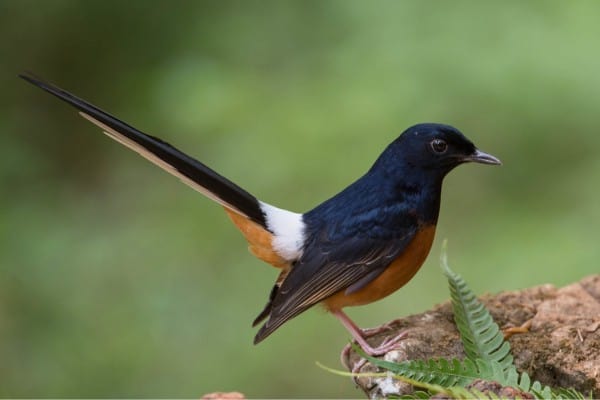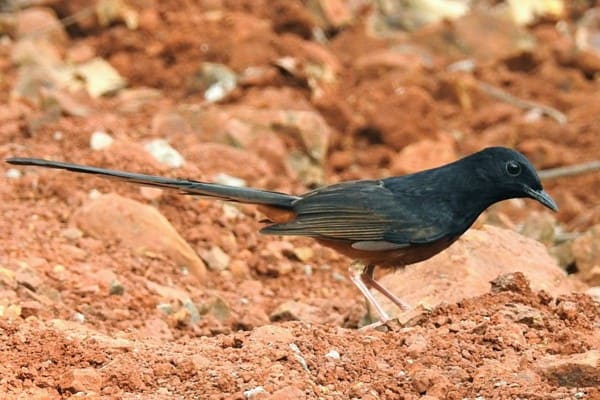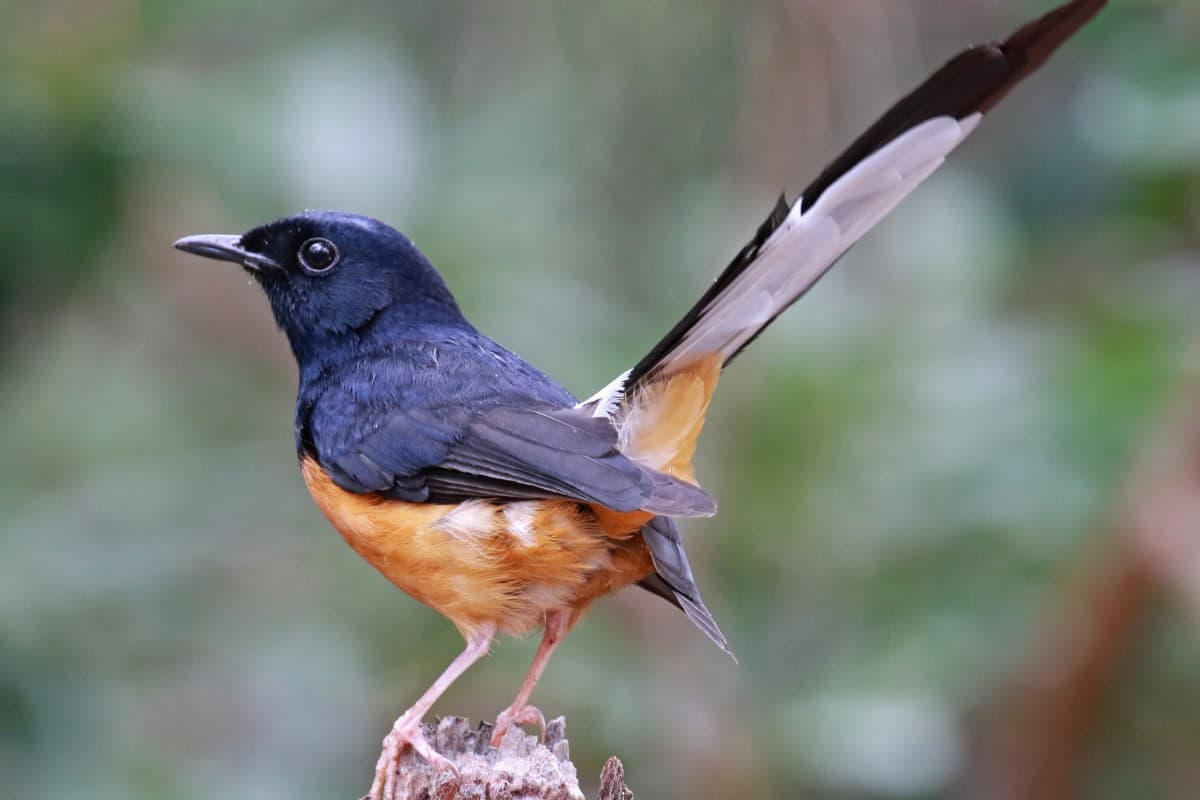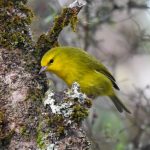Common Name: White-rumped Shama
Scientific Name: (Copsychus malabaricus)| Size | Diet | Range in Hawaii | Status in Hawaii |
|---|---|---|---|
| 9 in. | beetles, ants, termites, and grasshoppers | Ni'ihau, Moloka'i, and Lana'i | Least Concern |
The White-rumped Shama, also known as Copsychus Malabaricus, is a small passerine bird species that is native to the Indian subcontinent and Southeast Asia. However, it has also been introduced to other parts of the world, including Hawaii, where it has become a naturalized resident.
Despite being a non-native species, the White-rumped Shama has been long established in Hawaii and is a beloved sight among birdwatchers on the islands. In this article, we will explore more about the White-rumped Shama, its unique characteristics, and its presence in Hawaii.
White-rumped Shama
Appearance

The White-rumped Shama is a small passerine bird species that is approximately 23 cm (9 inches) in length. The males have glossy black plumage on their head, back, and wings, with a rich chestnut color on their belly and rump.
They also have a distinctive white patch on their lower back. The females have similar coloration but are slightly paler. Both males and females have a long, graduated tail that is often held upright.
Diet
The White-rumped Shama is an omnivorous bird species that feeds on a variety of foods. Its diet consists primarily of insects, including beetles, ants, termites, and grasshoppers.
It also eats fruits, seeds, and nectar. In captivity, the White-rumped Shama has been known to eat mealworms, crickets, and other commercially available insect foods. The species is known for its foraging behavior, which includes hopping on the ground and in low vegetation in search of prey.
The White-rumped Shama’s diverse diet allows it to thrive in a variety of habitats, from forests to gardens and parks.
Nesting
The White-rumped Shama is known for its elaborate and intricate nesting behavior. The species builds a cup-shaped nest out of twigs, grasses, and other materials, often incorporating spider webs to help bind the structure together.
The nest is typically located in a tree or shrub, and the female lays 2-4 eggs that are incubated for around 12-14 days. Both parents take turns incubating the eggs and caring for the young. The chicks are born naked and helpless, and are fed a diet of insects and other small invertebrates until they are old enough to leave the nest.
The White-rumped Shama is a dedicated parent and takes great care in building and maintaining its nest, ensuring the survival of its offspring.
Behavior

via Wikimedia Commons | CC BY-SA 4.0
The White-rumped Shama is known for its unique and varied behavior. The species is highly active and is often seen hopping and flitting through the underbrush in search of food.
It is also known for its melodious singing, which includes a varied series of loud whistles and trills. The White-rumped Shama is a social bird and is often found in pairs or small groups.
It is also known for its aggressive behavior towards other birds and will defend its territory fiercely. The species is diurnal and is most active during the day, spending its nights roosting in trees or shrubs.
Habitat
The White-rumped Shama is a bird species that is native to densely vegetated habitats in the Indian subcontinent and Southeast Asia. The species is adapted to a variety of habitats, including tropical and subtropical forests, gardens, parks, and plantations.
It is also known to inhabit areas near rivers and streams. In Hawaii, where the species has been introduced and has become a naturalized resident, the White-rumped Shama is often found in suburban and urban areas, as well as in forested regions. The species prefers areas with dense vegetation and a variety of food sources, as well as access to water.
Range
The White-rumped Shama is an introduced bird species in Hawaii, primarily found in the Southeastern Hawaiian Islands. It was originally introduced to Kaua’i in 1931 and O’ahu in 1940.
Since then, the species has spread naturally to Ni’ihau, Moloka’i, and Lana’i. White-rumped Shamas are not native to Hawaii but have established populations in these specific islands.
Conservation Status

The White-rumped Shama is currently listed as a species of “Least Concern” by the International Union for Conservation of Nature (IUCN). This designation suggests that the species is not facing any immediate or significant threats to its survival.
Interesting Facts
1. Melodious song
The male White-rumped Shama is known for its beautiful and melodious song, which consists of a wide range of musical notes and phrases. It is often described as one of the most enchanting bird songs.
2. Mimicry abilities
White-rumped Shamas have exceptional mimicry skills and can imitate the sounds of other birds and even some human noises. They incorporate these mimicked sounds into their complex songs.
3. Territorial behavior
Male White-rumped Shamas are highly territorial and defend their territories vigorously. They use their melodious songs as a way to establish and defend their territory boundaries.
4. Vivid plumage
While both male and female White-rumped Shamas have similar overall appearances, the males typically exhibit more vibrant and intense coloration, especially during the breeding season. This colorful display helps attract females.
Frequently Asked Questions
1. How long do White-rumped Shamas typically live?
White-rumped Shamas have an average lifespan of around 6 to 8 years in the wild. However, with proper care and protection from predators, some individuals may live up to 10 years or more.
2. Are White-rumped Shamas known for their singing ability?
Yes, White-rumped Shamas are renowned for their melodious and complex songs. Males have a wide repertoire of melodic tunes and can mimic various sounds, including other bird species. Their songs are often used for territorial defense and attracting mates.
3. Are White-rumped Shamas territorial birds?
Yes, White-rumped Shamas are territorial and defend their chosen territories vigorously. They use their melodious songs as a means of defending their territory and warning other males to stay away.
4. Do White-rumped Shamas perform elaborate courtship displays?
Yes, during the breeding season, male White-rumped Shamas perform impressive courtship displays to attract females. These displays involve intricate flight patterns, exaggerated wing flapping, and singing performances to showcase their fitness and attract a mate.




